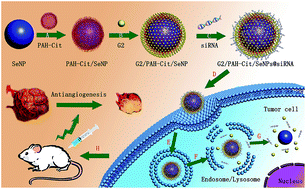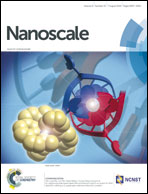The use of pH-sensitive functional selenium nanoparticles shows enhanced in vivo VEGF-siRNA silencing and fluorescence imaging†
Abstract
The utility of small interfering RNAs (siRNAs) has shown great promise in treating a variety of diseases including many types of cancer. While their ability to silence a wide range of target genes underlies their effectiveness, the application of therapies remains hindered by a lack of an effective delivery system. In this study, we sought to develop an siRNA-delivery system for VEGF, a known signaling molecule involved in cancer, that consists of two selenium nanoparticles SeNPs and G2/PAH-Cit/SeNPs. A G2/PAH-Cit/SeNP is a pH-sensitive delivery system that is capable of enhancing siRNA loading, thus increasing siRNA release efficiency and subsequent target gene silencing both in vitro and in vivo. In vivo experiments using G2/PAH-Cit/SeNPs@siRNA led to significantly higher accumulation of siRNA within the tumor itself, VEGF gene silencing, and reduced angiogenesis in the tumor. Furthermore, the G2/PAH-Cit/SeNP delivery system not only enhanced anti-tumor effects on tumor-bearing nude mice as compared to SeNPs@siRNA, but also resulted in weak occurrence of lesions in major target organs. In sum, this study provides a new class of siRNA delivery system, thereby providing an alternative therapeutic route for cancer treatment.


 Please wait while we load your content...
Please wait while we load your content...